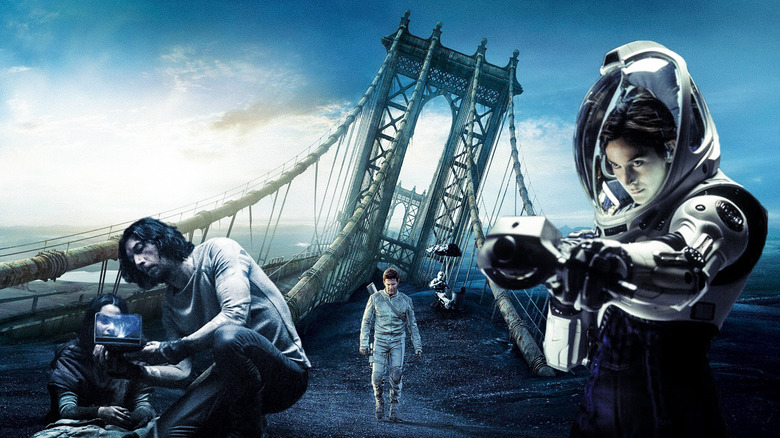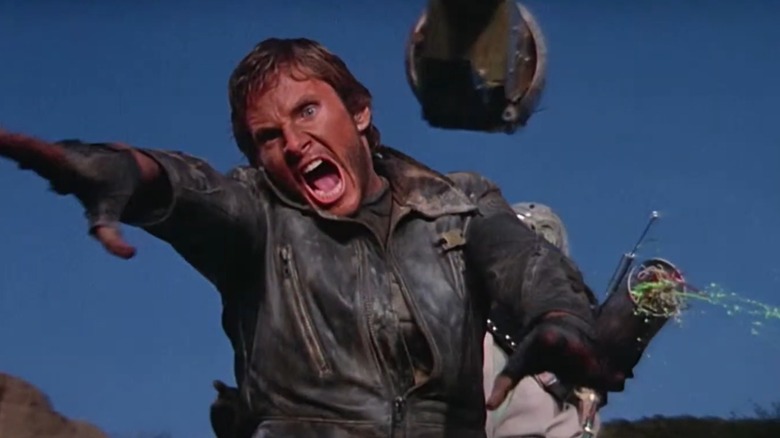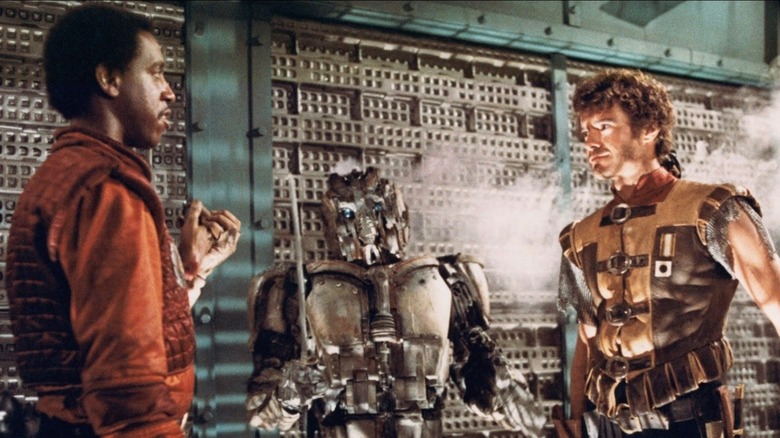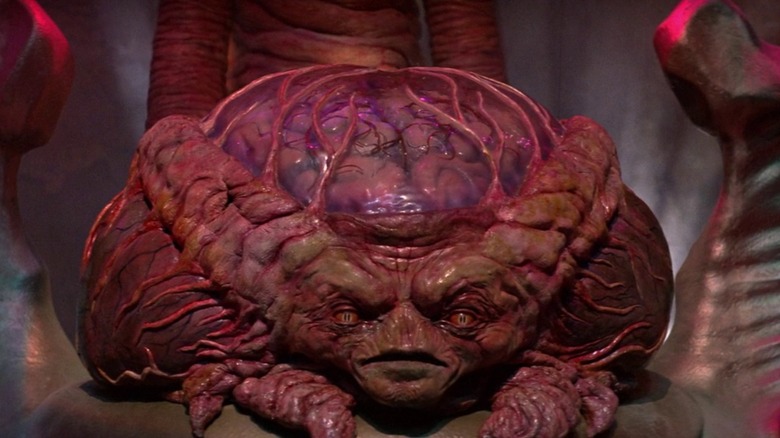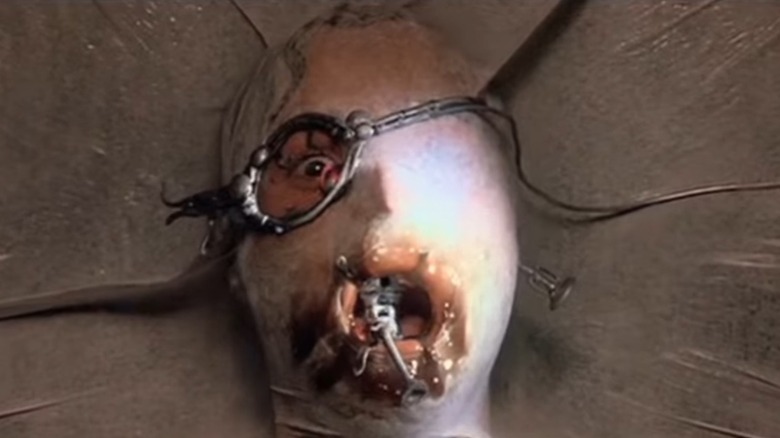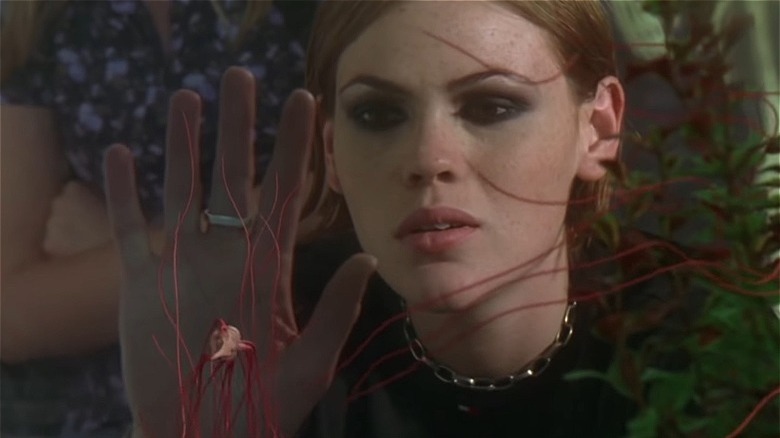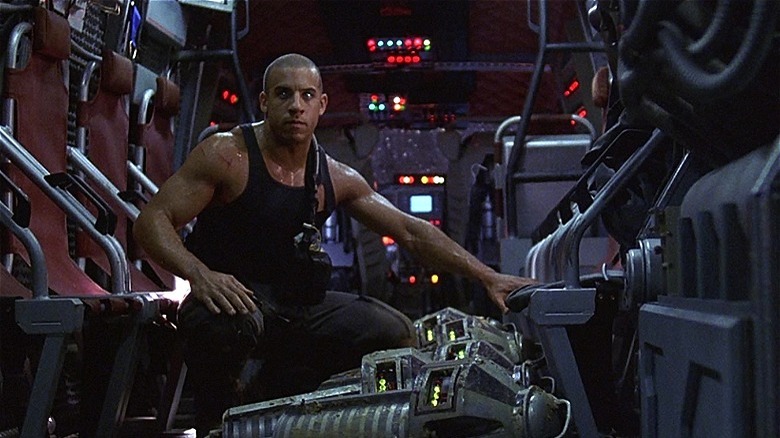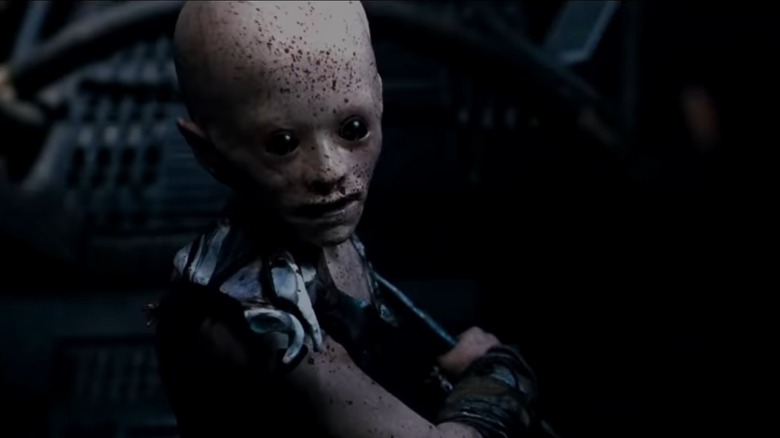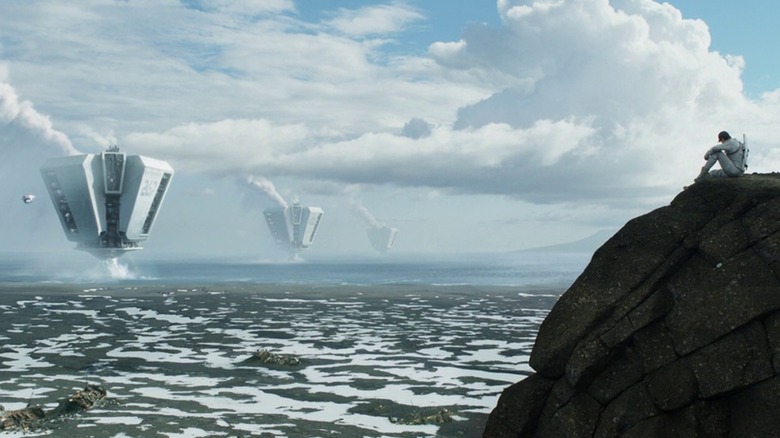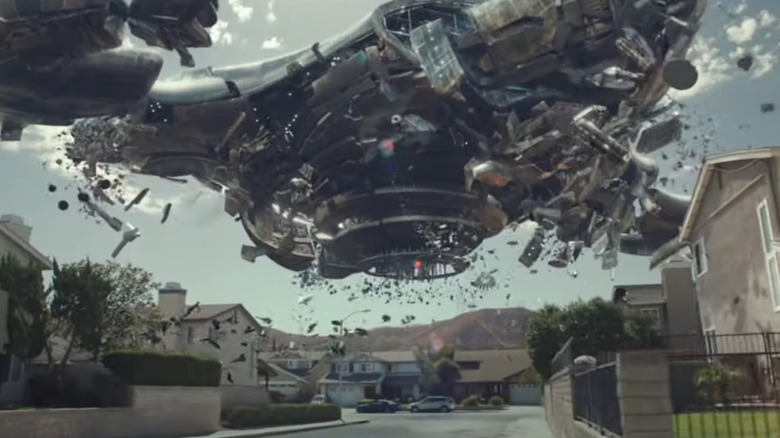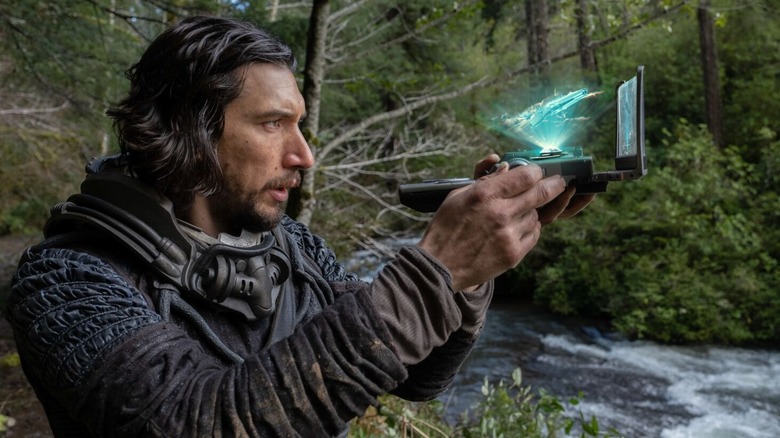20 Critically-Panned Sci-Fi Movies That Are Actually Worth Your Time
Science fiction is the exploration of our practical imaginations. Stories in the genre can be fantastic, uplifting, or horrifying, but they need to remain grounded in a scientifically applied reality — a reality we already understand or one that's clearly explained. Without these rules governing our experiences, our exploration becomes untethered from reality and sails off into obscurity, and no CGI velociraptor, animatronic android, or puppet-like killer shrew is going to save it. Or can it? If Dr. Ian Malcolm were a film historian, his cinematic chaos theory would predict that over time, lovingly crafted cinema, like life, breaks free, expands to new territories, and crashes through barriers, painfully, maybe even dangerously.
In their era, masterpieces like "The Thing" may have been a little too much for audiences. Some critics struggled to see the beauty present in John Carpenter's classic beyond the gore and creatures, and it was even detested by star Kurt Russell for a little while. Over time, though, a cinematically enlightened public can now appreciate the artistry behind the chest-ripping — and recognize the plot's central themes about the frailty of man (men, really) and the decay of humankind.
In that spirit, I present to you 14 critically panned sci-fi movies of the past that deserve more love and respect in the present and future. Similar to our list of critically-panned fantasy movies, we'll tell you why you should look past oldfangled perceptions to enjoy some of Hollywood's most imaginative and fun scientific explorations.
Beneath the Planet of the Apes (1970)
After the smash success of 1968's "Planet of the Apes," the studio followed it up in 1970 with the direct sequel "Beneath the Planet of the Apes." After the original movie's protagonist Taylor disappears investigating the ruins of New York City, another 20th century astronaut, Brent, arrives in this post-apocalyptic future. Pursued by the apes, Brent discovers a group of mutated humans living underneath the American city. This leads to a violent showdown determining Earth's final fate and which civilization will ultimately reign supreme.
The first half of "Beneath the Planet of the Apes" is largely a retread of the original movie, albeit from Brent's perspective instead of Taylor's. Once Brent finally goes subterranean and the sequel lives up to its premise, the film actually takes off and goes into some genuinely interesting territory. Be warned, however, that the ending of "Beneath the Planet of the Apes" is bleak, making it the most grim chapter in the entire franchise to date. Really, though, "Planet of the Apes" was never a feel-good series, with the 1970 sequel embracing uncompromising nihilism in its execution. (Samuel Stone)
The Black Hole (1979)
Space is an infinite void, but it's rich with potential. Disney spent $20 million to send the USS Palomino on a mission to mine "Star Wars" and "Star Trek" fans for box office receipts. It worked; Disney took in $37 million but the ride was bumpy. In 1979, Ebert called "The Black Hole" a talky melodrama and labeled the black hole a gimmick. He's right. There is too much chatter and the black hole is just a backdrop, but it looks fantastic. The artistic team created 150 matte paintings, hand-made models, and projections of models to establish a sensational celestial setting.
I get the problem — "The Black Hole" feels like one "Star Wars: A New Hope" scene stretched out over 98 minutes. That doesn't take away from the vivid visual work that won the movie two Oscars or John Barry's fun, futuristic score. You may laugh at some of the robot designs that didn't age well, or the voices behind them (Slim Pickens as a robot? What?!?), but it's a journey worth taking. The climax's "sensational visual payoff" (Ebert's words, not mine) is amazing even today and is followed by an ending that looks like an Iron Maiden album cover summoned into "Fantasia." Despite the bumpy ride, "The Black Hole" is one I'll take again when Disney finally releases a 4K version. (Brendan Knapp)
Metalstorm: The Destruction of Jared-Syn (1983)
Resources are limited in most post-apocalyptic wastelands. I'm sure resources were limited making "Metalstorm: The Destruction of Jared-Syn." It may have been hustled onto film, as Arnold suggests, but it's still done with enough care to stand out among the era's many post-nuclear landscapes. "Metalstorm" treads the path that "Mad Max" wore deep into its dust-covered, sun-drenched backlands — and I'm fine with that. Any time I see a gang of mutant humanoids rolling deep in a hand-welded death truck, I'm calling shotgun.
Speaking of mutant humanoids, Richard Moll gives his everything as Hurok, leader of the Cyclopeans. Commitment is a common theme in every low-fi, sci-fi cinematic wasteland that shows signs of life on screen. You can tell when the actors want to be there. Moll said he reached out for his role knowing it required extensive makeup. When you get people to buy in, it shows, like when Tim Thomerson inserts a little Han Solo sidekick charm into Rhodes and Michael Preston flashes his "Mad Max" pedigree as the powerful Jared-Syn. Sure the slo-mo fight sequences drag and the chases go nowhere, but there's enough cinematic sparkle for genre fans to enjoy — now in 3D! The Shout Factory gang mined a 3D transfer for its Blu-ray. Good luck finding "Metalstorm" anywhere else. (Brendan Knapp)
The Ice Pirates (1984)
"... bewildering, exceedingly jokey science fiction film that looks like a 'Star Wars' spinoff made in an underdeveloped galaxy." — Vincent Canby, The New York Times, March 16, 1984
I love when movies make an early promise about the experience you're about to have. "Ice Pirates" wastes no time as Robert Urich, Anjelica Huston, Michael D. Roberts, and Ron Perlman (how's that for a cast!?) bust through a spaceship bathroom, interrupting an alien mid-discharge, just to bungle an ice caper with all the face-planting flair of an amateur ice capade. This quasi-"Star Wars" is underdeveloped, but its half-baked goofiness still lands for me.
"The Ice Pirates" is a satire that targets the usual suspects. "Star Wars," "Robin Hood," "Alien," and "Mad Max" all get ribbed, but this is no one-trick pony. The gags and one-liners stand on their own, though they have a nip of boozy sway to them and range from bawdy (castration assembly line) to buffoonish (clumsy robots), childish (space herpes) to sometimes dark (baby robot cries for dead mom), and occasionally offensive (you'll see). The low-brow humor, though, isn't what drives the movie. Every street, spaceship, and cantina teems with creative life. Few "Star Wars" copycats of this era show this kind of thoughtfulness with their prop usage, set design, space-age costumes, and commitment from extras and side characters. The movie can be bewildering at times because of the excessive jokes, but that's also the fun of it. (Brendan Knapp)
Firestarter (1984)
By the '80s, Stephen King started to branch out from explicitly supernatural horror into other genres, with his 1980 novel "Firestarter" blending sci-fi with elements of government conspiracy thrillers. The 1984 adaptation has a couple experimented on by a secret government agency gain telepathy, while their daughter Charlie develops pyrokinesis, the dangerous ability to control fire. After learning what Charlie is capable of, the government pursues the family, intent on weaponizing her burgeoning superpower. With Charlie's powers growing rapidly, the girl's powers are her best hope to free herself from a life on the run or manipulated by shadowy figures in the government.
The impact "Firestarter" had on "Stranger Things," with Charlie's journey serving as a strong parallel to Eleven's, is a prominent feature of the 1984 movie (which has since been remade by director Keith Thomas). That said, "Firestarter" lacks the same spark that has made "Stranger Things" such an entertaining show and cultural phenomena. Still, supporting actors George C. Scott and Martin Sheen shine through the relatively lackluster material while Tangerine Dream's original score elevates the movie. There are far worse King adaptations than the 1984 "Firestarter," including that uninspired 2022 remake. (Samuel Stone)
Invaders from Mars (1986)
"Invaders from Mars" is not scary. However, it is a Cannon movie and a collaboration between Tobe Hooper ("Poltergeist") and Dan O'Bannon ("Return of the Living Dead") — and that should be enough to grab your interest. In the director's chair, Hooper shows off what he learned from his "Poltergeist" partnership with Steven Spielberg. "Invaders" is soaked with sunny suburban Amblin vibes. There's even a frog-in-the-jar classroom scene. But we soon find out no one is safe in this small town, not a formaldehyde-infused frog and definitely not 12-year-old David Gardner. Hunter Carson brings just enough wide-eyed alarm and windmill-armed running to the role to make you feel David's anxiety as everyone turns on him — even his dad George (Timothy Bottoms doing his best Paul Rudd years before Paul Rudd was doing Paul Rudd).
The first half of "Invaders" feels like a kid's version of "Invasion of the Body Snatchers." The second half ditches the mystery and goes full-on creature feature. Hooper and effects master Stan Winston immerse us in a wondrous practical effects-laden alien environment. I respect the artistry of modern CGI, but it's a treat to see real hands-on craftsmanship of this level executed on screen, even if it makes you smile and not scream. (Brendan Knapp)
Alien 3 (1992)
"Director Fincher is best known for his music videos and his MTV sensibilities are in full evidence, right down to the film's breakneck pace and jagged editing." — Marc Savlov, The Austin Chronicle, May 29, 1992
In space, no one can hear you scream, especially about disliking movies from director David Fincher. Sure, "Alien 3" is not the horror classic "Alien," and it's not the action classic "Aliens." The story struggles to grab us because it doesn't bring much new to the screen. Ellen Ripley (Sigourney Weaver) is no longer an underdog and Xenomorphs are as beloved as Beanie Babies. Never fear, though, because Fincher knows how to torment characters, and this movie changed the director's entire approach to filmmaking.
He crashes Ripley and a Xenobyte into a space prison where murderers, molesters, and rapists have all sworn oaths of celibacy. She upsets that balance, turning these reformed people into monsters of a different kind. Before they get Ripley, though, chests start bursting and the action takes off. You may not like Fincher's fast-paced editing, but it's a style that the award-winning director has become known for later in his career. The camera is jittery and the material has been covered before, but this is David Fincher making his directorial debut with the "Alien" franchise. If that doesn't make you scream in ecstasy, it might be time for a new hobby. (Brendan Knapp)
Fire in the Sky (1993)
The first hour of "Fire in the Sky" is tedious. It's peppered with abduction flashbacks, but never makes you care about any of the people involved, including abductee Travis Walton (D.B. Sweeney). Yet, you endure because you know what's coming: 13 minutes of what's essentially alien torture porn. Roger Ebert says the 13 minutes "convincingly depict a reality I haven't seen in the movies before, and for once I did believe that I was seeing something truly alien, and not just a set decorator's daydreams." This is 100% accurate.
The movie is based on the book of real-life self-described abductee Travis Walton, but he couldn't remember the juicy abduction details. The studio brought in professional alien punch-up writer Tracy Torme (yes, son of Mel) to rework the movie and get under our skin –- and, boy, does he. You squirm in your seat as Walton tries to escape his alien tormentors. You want to look away but you can't because you need to eyeball every inch of the screen. Not to be outdone, composer Mark Isham somehow pulls off the impossible task of matching the disturbing visuals by scraping the back of your skull with his hollow, unearthly score. If you survive the first hour, I promise you that Ebert is right, and the abduction sequence will take you to a place you haven't been to before. (Brendan Knapp)
Event Horizon (1997)
If "Alien" is "Jaws" in space, "Event Horizon" is "In the Mouth of Madness" in space -– replete with a maniacal Sam Neill. Director Paul W. S. Anderson is known for putting style before substance. But I think he finds a balance here. Anderson was inspired by "2001: A Space Odyssey" and "Alien," which may be why he's a little more reserved ... for him. Most of the horror and gore is shown in flashes — only a few times do you see someone bathed in blood. As I said, it's reserved for Anderson.
The story could have more thoroughly shown Dr. Billy Weir's (Neill) descent to evil instead of throwing him over the edge. One minute Dr. Weir is trying to save a life, the next he sneaks back into the shadows devilishly whispering, "I am home." What a home it is. Anderson uses full-scale models for the interior instruments and meticulously crafted scale models for exterior shots of the ships. Anderson even scanned Notre Dame Cathedral in Paris to bolster every aspect of the Event Horizon ship, as the cathedral was designed to "intimidate the populace." He nailed the space-horror aesthetic, because whenever this movie comes on, I darken the room, sneak back into the shadows of my living room, and devilishly whisper, "I am home." (Brendan Knapp)
Star Kid (1997)
The idea of a loveable outcast kid befriending an otherworldly entity is a cinematic trope that's been prevalent since the runaway success of 1982's "E.T. the Extra-Terrestrial" (which Steven Spielberg almost turned into a horror movie) But 1997's "Star Kid" provides its own twist on this sci-fi coming-of-age narrative, blending it with some Power Rangers-esque super sentai sensibilities. When shy middle schooler Spencer stumbles across a sentient alien exosuit, he starts wearing it to impress his crush or get back at a local bully. However, a hostile enemy at war with the exosuit's creators detects its presence on Earth, leading to a harrowing confrontation.
In lesser hands, "Star Kid" could've been a run-of-the-mill sci-fi wish fulfillment story, like "Blank Check" with a knock-off Iron Man armor. A lot of what makes this movie work is an earnest performance from star Joseph Mazzello, who had previously brought a similar wide-eyed wonder to "Jurassic Park." Whenever "Star Kid" leans into the superhero genre, it falters, running better as a comedy of Spencer learning how to operate his new exosuit. And as far as children's movies go, you can do a lot worse than this overlooked '90s blast from the past. (Samuel Stone)
The Faculty (1998)
"I'm a contradiction" is a line said in "The Faculty" that any character could have stated. Zeke Tyler (Josh Hartnett) is a brilliant flunkee. Delilah Profitt (Jordana Brewster) is a clueless news editor. Casey Connor (Elijah Wood) is a defiant bully victim. "Everyone is a contradiction" should have been the tagline of the movie and, guess what, there's a Tommy Hilfiger outfit to match every archetype. Yet, if you look beyond the aggressively marketed pop-collared polos and goth-mock turtlenecks, you'll find a fully developed sci-fi horror flick.
Director Robert Rodriguez expertly lays a trap for you by not showing too much early and by making you care for a handful of characters, even if they are somewhat cookie-cutter. The script is not great — it's full of ground-up high school tropes and the kind of hyper-intelligent chatter that bogged down many late '90s movies — but it still feeds you a nourishing storyline. There's a creature on campus that's controlling the faculty and the kids will have to do more than stand on their desks to revolt. The movie unfolds like "Invasion of the Body Snatchers" or "The Thing;" everyone is a potential alien. It is low-grade fun, and perfectly embodies its era, especially the soundtrack. (Brendan Knapp)
Red Planet (2000)
In a synchronicity echoing the arrival of "Volcano" and "Dante's Peak" or "Deep Impact" and "Armageddon," 2000 saw two movies released about Mars. Coming out eight months after Brian DePalma's "Mission to Mars" was Antony Hoffman's "Red Planet," also about an ill-fated expedition on Mars. As humanity begins terraforming Mars for eventual colonization, a gamma-ray burst causes severe equipment malfunctions on the planet. Stalked by a rogue robot sentry and facing the harsh environmental conditions on Mars, the small crew attempts to survive and find a way to return home.
While neither "Red Planet" nor "Mission to Mars" were successful commercially or critically, "Red Planet" is the better of the two films, despite failing at the box office. Whereas "Mission to Mars" tries to maintain an artful sensibility about it, "Red Planet" is a relatively straightforward sci-fi action movie. Stars Val Kilmer and Carrie-Anne Moss, with the latter fresh off "The Matrix," are engaging enough, even as the harder sci-fi elements fall flat. While "Mission to Mars" veers too far into cerebral existentialism, "Red Planet" understands the assignment and keeps things moving briskly as a pleasant enough diversion. (Samuel Stone)
Pitch Black (2000)
Long before Vin Diesel preached about family in the "Fast and Furious" universe, he wandered the galaxy as a Furyan fugitive named Richard B. Riddick, dodging bounty hunters and death. "Pitch Black" kicks off the trilogy with a sci-fi horror film that won over audiences, but divided critics. Critics called the film derivative, saying its creatures, landscape, and plot remind them of "Jurassic Park," "Mad Max," and "Alien." Is that such a bad thing?
The cast is excellent. Yes, Diesel chews rocks for dialogue, but it works. He's a gritty former soldier who's been buried alive under rubble and held in a subterranean prison. Radha Mitchell and Keith David lead a talented supporting cast. The world is dark but beautiful, with lighting only where it needs to be. The camera work cleverly follows the action from multiple perspectives. The creature chases are tense and the jump scares are earned. Many sci-fi and horror fans may be surprised to see "Pitch Black" on this list, but it was certainly panned. Bob Graham of the "San Francisco Chronicle" gave it a 0 out of 100, calling it a tiresome experience. Of course, that same year, he gave "Space Cowboys" a 100 out of 100, so take his review with a grain of salt (or rock, if you're Riddick). (Brendan Knapp)
Jason X (2001)
The slasher movie genre, including the "Friday the 13th" series, is as formulaic as it gets, with its relentless masked killers carving their way through hapless young adults. 2001's "Jason X" gives the venerable franchise a much-needed shot in the arm by catapulting its eponymous slasher over 400 years into the future. The cryogenically frozen Jason Voorhees is taken to a space station for research, only to resume his killing spree after reviving from his lengthy stasis. More than just picking up where he left off, Jason upgrades his murderous methods to reflect this far-future setting, making him deadlier than ever.
The "Friday the 13th" movies tend to work better when they go more over-the-top and self-aware with its premise, and none are more delightfully absurd than "Jason X." From Jason recreating his classic kills in a holographic simulation to gruesome new kills, the movie embraces its campy potential. "Jason X" marks the final movie appearance of Kane Hodder as Jason, his most noteworthy role, and the actor goes out with a darkly hilarious bang. (Samuel Stone)
Final Fantasy: The Spirits Within (2001)
By 2001, "Final Fantasy" was one of the biggest video game properties worldwide, with publisher Square deciding to parlay this success into creating its own movie studio Square Pictures. The studio's only completed project was the 2001 CG-animated film "Final Fantasy: The Spirits Within," directed by "Final Fantasy" creator Hironobu Sakaguchi. Rather than adapting any of the games, "The Spirits Within" followed an original story of a near-future Earth besieged by aliens, known as Phantoms. A hearty band of soldiers and scientists traverse the ravaged world to revive eight dormant spirits to drive the aliens away.
With high production costs exceeding $100 million, stemming from delays and development of cutting-edge animation technology, "Final Fantasy: The Spirits Within" was a critical and commercial bomb that almost put the studio out of business. While the story and its themes are fairly obtuse and its pacing is all over the place, "The Spirits Within" remains a visually stunning cinematic achievement. "The Spirits Within" plays out like a lush, surreal dream, where cohesive narrative is secondary to the overall viewing experience. "Final Fantasy" set a benchmark for realistic CG animation nearly a decade before James Cameron's "Avatar," and it stands as a criminally underrated video game movie. (Samuel Stone)
Pandorum (2009)
After 15 minutes into "Pandorum," you think you're watching a psychological thriller set in space, and then a bunch of mutants rumble across the screen and rip apart some guy. What!? This is a creature feature?! Yes, there are some scary moments, and the tension is ratcheted up in the first few minutes with a realistic (I assume) look at how awful waking up from extended hypersleep must be. The physical agony comes with a form of psychosis called pandorum that's provoked by stress — and (I assume) your situation gets even more stressful when a gang of mutants starts running toward you on all fours, armed with sharpened, fire-protruding instruments of death.
"Pandorum" reminds me, in some ways, of "The Descent." It's claustrophobic and the only thing cast in light is what director Christian Alvart wants you to see. You don't get to scan the screen for potential terrors; they're on you before you know it. The creatures, best described as a mix of the underground dwellers from "The Descent" and the Uruk-hai from "The Lord of the Rings," are the true horrors of this ship, not the titular space psychosis. The effects of pandorum, though, add a layer of tension that drives the film's climax and sets you on course for a pleasant surprise ending. (Brendan Knapp)
Oblivion (2013)
All right, I forgot I had seen "Oblivion." My wife reminded me it's the one with Tom Cruise as WALL-E. Upon rewatch, it's easy to see "Oblivion" is overly complicated, with too many big sci-fi concepts that are integral to the central story. There's an alien invasion, a cataclysmic event, an escape ship to save civilization, cloned people, survivors underground, and other survivors sleeping in space — but only some of those things are real. If you step back, the story arc looks like the tangled ball of Christmas lights Clark Griswold pulls out of his garage. It's a lot for our brains to untangle.
On second viewing, the cord does start to unravel. You can follow the story arc back to its origin point, and once plugged in, the whole thing lights up wonderfully. The movie is sci-fi eye candy, and those of us who've been paying attention are not surprised. Director Joseph Kosinski is behind the "Gears of War" commercial many of us geeked out to in 2006, and he expertly landed "Top Gun: Maverick" in 2022. Watch "Oblivion" again and look to the far corners of your screen. Take in the dazzling effects that bring this beautifully damaged world to life and sit forward for the heart-jolting action sequences. Once you understand the story, it becomes a world you won't forget. (Brendan Knapp)
Earth to Echo (2014)
"Earth to Echo" is not simply an "E.T." rip-off. It's an homage, a rendition of a classic, and its source of inspiration is so obvious that it reverberates in its title: "Earth to Echo" or "E.T. Echo." A neighborhood, just like the one that felt so alive in "E.T. The Extra-Terrestrial," is in danger of being torn down to build a freeway, a social and racial issue rarely explored in movies. It turns out the freeway work is a front for an organization trying to capture Echo, but a group of intrepid kids won't let that happen. It's a familiar story for "E.T." fans — especially the kids-on-bikes-save-the-alien theme — but the directing style differentiates itself enough that it becomes its own experience.
Though by this point, the found footage approach to story telling was a bit tired, "Earth to Echo" takes a refreshing approach by utilizing multiple photographic formats, including phones, GoPros, and video streams. The special effects also elevate the movie, as Echo uses telekinesis to reassemble his ship from scrap parts that come from all over your screen. Overall, there are enough parts assembled from "E.T." that the film successfully transports Amblin fans back to the San Fernando Valley, but the modern tools used here tell the story in a way that's familiar to a new generation of sci-fi fans. (Brendan Knapp)
Underwater (2020)
Underwater, no one can hear you scream awful phrases like, "I wanna tie myself to you in every humanly way possible." Forget the fang-banging Kristen Stewart of yore. A new, powerful KStew has ripped through that porcelain-skinned doll who fawned over faux monsters. As Norah Price in "Underwater," she faces a real threat. Price is the mechanical engineer of a drilling facility that's uncovered something horrible seven miles below the water's surface and she's going full Ripley to take it down. To the untrained eye, "Underwater" is indeed a waterlogged "Alien" rip-off. Those of us who immerse ourselves in sci-fi creature features will call out that false comparison because we know that "Underwater" is really a waterlogged "Cloverfield" — and it's fantastic.
There's no shaky "Cloverfield"-style camera to make you sick, though the tight confines of the collapsing Kepler 822 can make you queasy. Some of the movie's murky shots are too much for Burr and other critics to swallow, but if you look past that murkiness, something big is lumbering your way: an immense and intense creature feature. If you're not a Kristen Stewart fan, don't worry, after seeing "Underwater," you'll be 100 percent Team KStew. (Brendan Knapp)
65 (2023)
In between leadding award season fare like "The Last Duel" or "Ferrari," Adam Driver starred in the 2023 sci-fi action flick "65." Set 65 million years in the past, a space-traveler named Mills and a young girl crash on Earth, when it was filled with dinosaurs. Forced to fend for themselves, Mills takes point in defending his fellow survivor as they are constantly attacked by the ravenous dinos at every turn.
Though critics were less than enthused by the bare-bones plot and shallow characterizations, "65" is a surprisingly effective action-adventure movie with sci-fi overtones. Anyone who felt let down by the dino action in the recent "Jurassic World" movies will be satisfied by the stirring set pieces in "65." Driver isn't necessarily swinging for the fences, but is believable enough as a conventional action star to carry the whole movie. "65" is an enjoyable thrill ride that nails much of its dino-based scares and action, clocks in at just 93 minutes, and avoids overstaying its welcome. (Samuel Stone)
